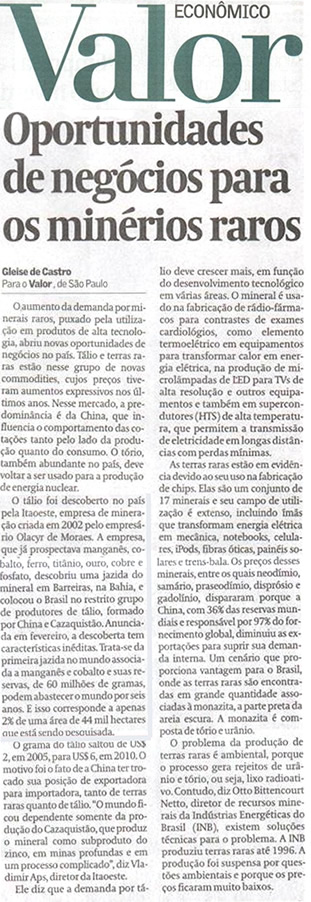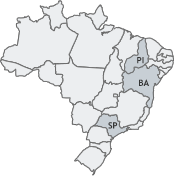
Business opportunities for rare minerals
The increase in demand for rare minerals, boosted by their use in high-technology goods, has opened new business opportunities for the country. Thallium and rare earths are in this group of new commodities, with prices that have catapulted in recent years. China is predominant in this market and influences price behavior in the production as well as the user side. Thorium, also abundant in the country, should be employed once again to produce nuclear electricity.
Thallium was discovered in the country by Itaoeste, a mining company organized in 2002 by businessman Olacyr de Moraes. The company which was already prospecting manganese, cobalt, iron, titanium, gold, copper, and phosphates, discovered a thallium deposit in Barreiras, state of Bahia, and placed Brazil in the restricted group of thallium producers, composed of China and Kazakhstan. The discovery which was disclosed in February, has unprecedented features. This is the world’s first orebody in association with manganese and cobalt, and its reserves of 60 million grams may be able to supply the world for six years. And this is equal to only 2% of a 44-thousand hectare area still being prospected by the company.
One gram of thallium rose sharply from US$ 2 in 2005 to US$ 6 in 2010. The reason was that China stopped exporting and began importing, not only thallium but rare earths also. “The world has had to depend only on Kazakhstan’s production, where this metal is a by-product of zinc, in deep mines and with a complex process,” explained Vladimir Aps, director of Itaoeste.
He reports that demand for thallium should expand even more, by virtue of technological development in a number of segments. This mineral is employed in the production of radio-pharmaceuticals, for cardiologic exam contrasts, as a thermoelectric element in equipment to convert heat into electricity, in the production of LED micro-lamps, for high-resolution TVs, and other equipment in addition to high-temperature superconductors (HTS) that will allow transmitting electricity over long distances with minimal losses.
Rare earths are in evidence owing to their use in producing chips. They form a group of 17 minerals and their field of application is vast, including magnets that convert electricity into mechanical energy, notebooks, mobile phones, iPods, optic fibers, solar panels, and high-speed trains. The prices of these minerals, among which are neodymium, samarium, praseodymium, dysprosium, and gadolinium, have catapulted because China, which owns 36% of world reserves and accounts for 97% of the world’s supply, has reduced exports in order to meet its domestic demand. A scenario that provides an advantage to Brazil, where rare earths are found in large amounts associated with monazite, the black portion of dark sands. The problem with the production of rare earths is environmental, because the process creates uranium and thorium residues, i.e. radioactive refuse. Nonetheless says Otto Bittencourt Netto, director of mining resources at Indústrias Energéticas do Brasil (INB), there are technical solutions to this problem. INB produced rare earths in 1996. Production was interrupted owing to environmental issues and because prices were very low.
Link: http://www.valor.com.br/impresso/empresas/oportunidades-de-negocios-para-os-minerios-raros (É necessário ter cadastro no site)

Rua Fidêncio Ramos, 160 – 2º andar – sala 211 – CEP: 04551-010 - Vila Olímpia – São Paulo - SP
Tel: (11) 3168-3705 | contato@itaoeste.com.br


